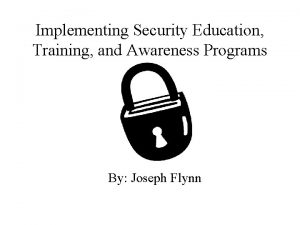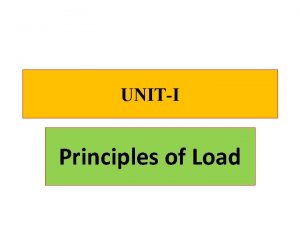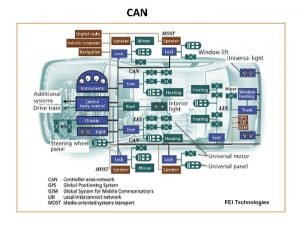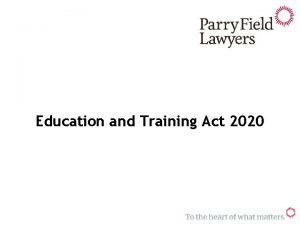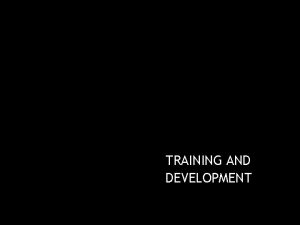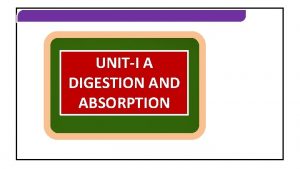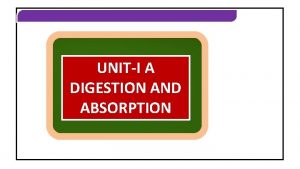ORIENTATION EDUCATION AND TRAINING UnitI ORIENTATION Orientation can










- Slides: 10

ORIENTATION, EDUCATION, AND TRAINING (Unit-I)

ORIENTATION • Orientation can be defined as the process that informs participants how to find their way within the organization. • Many organizations attempt to present detailed safety and hazard control information during new employee orientation sessions. • However, attempting to provide too much performance based safety education during orientation can prove ineffective due to time constraints. • New employee orientation sessions must address the importance of safety, management’s commitment, and worker responsibilities to practice good hazard control principles. • Some performance- based OSHA standards require that employees receive more detailed instruction that orientation sessions can provide. • Present this information in other education or training sessions.

EDUCATION • Education refers to the incorporation of knowledge, skills, and attitudes into a person’s behavior and includes the implication of thinking. • Education can provide information on topics previously trained. • System safety methods use Instructional Systems Design (ISD) educational and training methods to ensure the competency of individuals working in or supporting operations. • ISD requires development of competencies before designing educational and training sessions. • Sometimes the phrases job-related training or job safety training to refer to ISD

TRAINING • Training relates to the acquisition of specific skills, as the process of presenting information and techniques that leads to competency of those participating. • Conduct hands-on training outside of a classroom if possible unless using realistic simulation processes. • Effective training must strive to promote understanding, positively impact worker attitudes, and improve individual performance. • Training must facilitate the transfer of knowledge and skills that relate to real-world activities. • Many organizations do not dedicate sufficient time, allocate sufficient resources, or require attendance at training and education sessions.

Providing Adequate Sessions • An around-the-clock operation makes the education and training of shift employees even more challenging. • Educate and train shift workers prior to or during their shift but never after the shift. • Many organizations do not honestly evaluate training and education effectiveness. They maintain attendance or participation documentation. • Suggest using a short quiz or performance assessment to document learning. • Consider the use of employee safety meetings to educate workers about on- and off-the-job safety topics. • Publish an education and training policy statement to outline goals and objectives. • Use various methods to communicate hazard control and safety topics such as posters, flyers, bulletins, newsletters, classroom presentations, onthe-job training sessions, professional seminars, safety education fairs, and computer-assisted training. • Some organizations delegate a number of training responsibilities to the individual departments. Other organizations employ a full-time educational coordinator.

Training and Hazard Control • Hazard control managers and training personnel must coordinate education and training objectives • Conduct training for employees transferring to new jobs or work areas, returning from an extended period away from the job and those new to the work force. • Schedule training sessions to match the needs of the organization and needs of learners. Always view education and training as organizational functions and never as programs. • Design education and training sessions by using clearly stated goals and objectives that reflect the knowledge and skills needs of people. • When implementing an effective hazard control education and training function, consider the following elements: (1) identify needs, (2) develop objectives, (3) determine learning methods, (4) conduct the sessions, (5) evaluate effectiveness, and (6) take steps to improve the process. • Some ways to evaluate training can include the following: (1) student opinions expressed on questionnaires, (2) conducting informal discussions to determine relevance and appropriateness of training, (3) supervisor’s observations of individual performance both before and after the training, and (4) documenting reduced injury or accident rates.

Training Methods • Instructional presentations can employ a variety of methods to improve learning. • The use of a pre-test permits instructors to evaluate the knowledge of participants before the session begins. A pretest can motivate some participants to learn key concepts and principles. • Informal discussions and lectures should incorporate time for questions and answers to encourage participation. • Demonstration methods permit the instructor to use a hands-on technique to promote the application of knowledge. • Since people learn in different ways, use a variety of training methods to promote learning. • Some methods of education and training include lectures, videos, class discussions, demonstrations, written exercises and quizzes, small-group exercises, hands-on exercises, on-the-job observation, and combination methods. • Some trainers develop and use games to review critical material, especially in refresher training sessions. • Refer to OSHA booklet Training Requirements in OSHA Standards and Training Guidelines (OSHA 2254). • Many organizations use interactive software and other web-based learning opportunities to meet training objectives.

Basic Questions to Ask about Training Sessions • Did the session cover critical issues or hazards? • Did the presenter use an appropriate instructional method? • Did the instructor cover all educational objectives clearly and concretely? • Did the objectives state acceptable performance expectations of participants? • Did the session simulate or address real situations? • Did the participants demonstrate a motivation to learn during the session? • Did the instructors encourage active participation by all participants? • Did the presenter ask participants to critique or evaluate the session?

Off-the-Job Safety Education • Organizations should consider presenting off-the-job topics to all employees. • Providing sessions that address off-the-job hazard control, safety, and health topics sends the message that the organization cares about its people. • Present information that addresses real-world issues such as summer and winter hazards, holiday safety, and traffic safety topics. • Health topics could address eating healthy, the importance of exercise, and managing stress. • Other topics to address could include home related topics such as fire safety and fall prevention. • Suggest presenting an off-the-job education on a monthly basis.

Instructional Systems Design (ISD) • ISD can help organizations identify what an employee should know and what competencies related to hazard control he or she must demonstrate. • The ISD approach promotes and supports acceptable performance by an employee or worker. • ISD can also identify deficiencies in task knowledge and work competencies. • Determine information about hazards and behaviors by conducting system and job tasks analysis. • When preparing to develop an education and training plan on an unfamiliar procedure or system, the JHA provides the foundation for success. • Add appropriate content to the plan based on the following: (1) reviewing accident and injury records, (2) requesting workers to describe their job and related hazards, (3) observing and interacting with workers performing their job tasks, and (4) comparing content of other training plans dealing with similar hazards or risks.
 Industrie stati uniti
Industrie stati uniti Rette corrispondenti agli assi cartesiani
Rette corrispondenti agli assi cartesiani Studenti prof uniti per
Studenti prof uniti per Un templu sfant versuri
Un templu sfant versuri Polycentric orientation examples
Polycentric orientation examples Suny pdp
Suny pdp Greek physical education
Greek physical education Define security education
Define security education Department of higher education and training
Department of higher education and training Post secondary education training and labour
Post secondary education training and labour Education and training career cluster definition
Education and training career cluster definition







